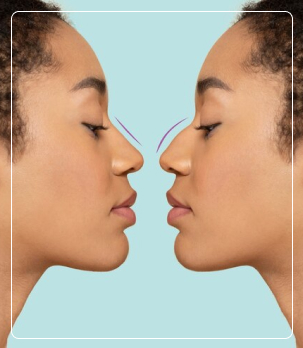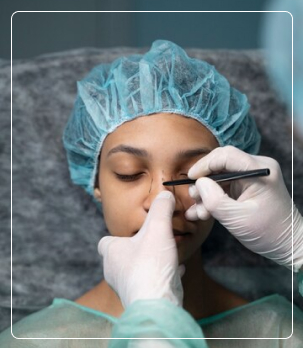Rhinoplasty
Plastic Surgeon in Kolkata
Rhinoplasty Surgeon in Kolkata
What is Rhinoplasty Surgery?
Rhinoplasty, or a nose job, is a surgical procedure to reshape and restructure the nose. It can be performed to improve the nose’s appearance, correct breathing difficulties or both.
Diagnosis and Procedure of Rhinoplasty Surgery
Diagnosis
Before rhinoplasty surgery, our doctor will ensure the patient is suitable for surgery and identify any factors that may affect the procedure or recovery. For instance, he will inquire regarding any past nasal or facial surgeries. He will also evaluate conditions such as allergies, respiratory issues or bleeding disorders.
Moreover, our doctor, Dr Anirban Ghosh, will ask about current medications, including over-the-counter drugs and supplements, that could impact the healing process.
He will perform a physical examination to check the physical structure of the nose and its relationship with facial features. To do this, he will evaluate the nose’s external appearance and internal anatomy and check the thickness and elasticity of the skin, which can affect surgical outcomes.
Diagnostic tests done by our surgeon include:

Nasal Endoscopy: A procedure where a thin, flexible tube with a camera is inserted into the nasal passages to examine internal structures.
CT Scans: In some cases, detailed imaging may be used by our doctor to check the nasal skeleton and sinus areas, particularly if there are functional issues.

Procedure
Generally, a rhinoplasty procedure involves:
Anaesthesia: You will be given either general anaesthesia (putting you to sleep) or local anaesthesia with sedation.
Incisions: Dr. Anirban Ghosh, a rhinoplasty doctor in Kolkata, generally makes incisions either inside the nose (closed rhinoplasty) or across the base of the nose (open rhinoplasty).
Reshaping: He will modify the underlying bone and cartilage to achieve the desired shape. This may involve removing, adding, or reshaping tissue.
Septum Correction: If you have breathing problems, our surgeon may correct a deviated septum at the same time.
Closure: The incisions are closed with stitches.
When is Rhinoplasty Surgery Recommended?
Rhinoplasty is usually recommended for individuals who are dissatisfied with the appearance of their nose or who have difficulty breathing due to nasal obstructions.
Common reasons for considering rhinoplasty include:
- Cosmetic concerns: The nose is too large, too small or has an undesirable shape.
- Breathing difficulties: A deviated septum, nasal polyps or other structural issues are causing problems.
- Injury-related deformities: The nose has been injured and requires reconstruction.


How to Prepare for Rhinoplasty Surgery?
To prepare for a rhinoplasty surgery, you must follow these guidelines:
Discuss Goals: Clearly discuss what you hope to achieve with the surgery. For this, you can talk about your aesthetic goals with our surgeon so that he knows how to address them during the procedure.
Review Your Medical History: Inform our surgeon about any health conditions, allergies or medications you are taking.
Medical Evaluation: He may require blood tests or other evaluations to check your health.
Medications: Follow instructions regarding any medications you need to stop or adjust. Normally, our doctor advises patients to avoid aspirin, nonsteroidal anti-inflammatory drugs (NSAIDs) and certain supplements that can increase the risk of bleeding.
Benefits of Rhinoplasty Surgery
As per Dr. Anirban Ghosh, our surgeon who specialises in rhinoplasty surgery procedure, the benefits of a nose job include:
Aesthetic Benefits
Improved facial harmony: A rhinoplasty can enhance your facial features, creating a more balanced appearance.
Increased self-confidence: A nose that aligns with your desired look can boost your confidence.
Correction of nasal imperfections: Rhinoplasty benefits further include addressing issues like a crooked nose, a bulbous tip or a nasal hump.
Functional Benefits
Improved breathing: Rhinoplasty can correct structural issues that cause difficulty breathing, such as a deviated septum or enlarged turbinates.
Reduced snoring: By addressing airway obstructions, rhinoplasty can eliminate snoring and improve sleep quality.
Alleviation of sinus problems: Some sinus issues can be resolved through rhinoplasty, reducing congestion and discomfort.

Recovery after Rhinoplasty Surgery
Recovery from rhinoplasty often differs from person to person but involves several stages:
Immediate Post-Surgery
Swelling and bruising: These are common and usually subside within a few weeks.
Nasal packing: Our surgeon might use packing to support the nose during healing.
Pain management: Mild discomfort can be managed with prescribed pain relievers.
Rest: It’s essential to rest and avoid strenuous activities during the initial recovery period.
First Week
Swelling reduction: The swelling will gradually decrease, but it may take several weeks for it to subside completely.
Splint removal: The nasal splint will be removed by our surgeon after a few days.
Stitches: If any external stitches are used they will be removed by our doctor.
Gentle activities: You can gradually resume light activities, but stay away from performing strenuous exercise.
Following Weeks
Healing progress: The nose continues to heal and reshape.
Final results: It may take several months for the final results to become apparent.
Follow-up appointments: Regular follow-up visits with our surgeon are essential to monitor the healing process.
Important Considerations
Avoid sun exposure: Protect your nose from the sun to prevent discolouration.
Sleep position: Sleeping on your back is recommended to minimise swelling.
Rhinoplasty recovery time can take weeks, and it’s important to be patient.

